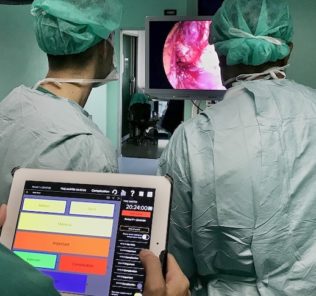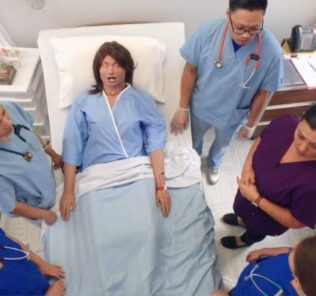The Future of Educational Escape Rooms for Nurses
Since the start of the coronavirus pandemic, educational facilities around the world have had to reconsider the ways education is delivered. Due to COVID-19 restrictions, delivering healthcare simulation virtually has been key for nursing learners. Medical stimulation, at the center of innovation, has changed education to a more learner-centered model. One of the newer methods that has been trialed with great success combines a medical simulation setting with the framework of a panic or escape room scenario.
Escape rooms were first made popular in 2007 in Japan and quickly grew in popularity around the world. Escape rooms designed for recreation tended to feature a theme and were often guided by a narrative to enhance role-play amongst the participants. Although there are similarities between recreational and educational escape rooms, the difference is that educational escape rooms are designed to teach specific skills based around well-defined learning objectives.
The escape room scenario is a challenge that requires participants to solve a series of tasks within a set time frame to be able to “escape” from the room. The concept behind the educational escape room, learning experience, is to create immersive, interactive ways for nursing learners to develop medical knowledge and skills that can be easily transferred into the real world. Inherently the puzzles are team-based and the key is to ensure every member of a team is active and can participate.
Sponsored Content:
The puzzles are designed to promote exploratory learning and can be divided into three core categories:
- Cognitive puzzles
- Physical puzzles
- Meta-puzzles
To enable learners to gain procedural knowledge, they are organized around four structures:
- Open structure, where players solve various puzzles simultaneously
- Sequential structure, where players solve the puzzles according to a particular sequence with each puzzle opening the next
- Path-based structure, where players solve several paths of puzzles using information gained from previous puzzles in order to solve the meta-puzzle
- Pyramid structure, where players solve a complex and hybrid form of puzzle, combining some or all of the above structures
Virtual escape rooms, featuring these structures and puzzle formats in medical stimulation, have proven to be an effective learning tool. Studies have shown that this style of interactive learning in a virtual environment improves and enhances collaboration and individual abilities to solve problems under pressure. This is especially relevant for nursing learners where time is of the essence and preventing errors, while taking the fastest and most appropriate action, can save lives.
Learning Methods with Virtual Escape Rooms
Sponsored Content:
The escape room creates a memorable way to combine visual, auditory and kinesthetic learning styles, which makes this type of learning tool suitable for all learning styles. The virtual escape room can be designed to include elements of clinical simulation for various numbers of learners, making the escape room flexible for individual medical facilities’ educational requirements. Additionally, the escape room provides a fun way to learn, which is vital to ensure nursing learners do not become burnt out when training in virtual environments.
This view is reinforced by Tracy Taylor, assistant professor of clinical practice part of the Digital Flagship at the College of Nursing at Ohio State University. “Hopefully it puts a fun spin on some of their work because we know that they’re probably overloaded with the online stuff right now,” Taylor said.
The tasks or puzzles that must be accomplished during an escape or panic room learning experience promote soft skills that are often challenging to teach including the promotion of:
- Effective communication
- Teamwork and collaboration
- Cooperative and organizational skills
- Critical and rational thinking
- Analytical skills
- Problem-solving strategies
- Creative thinking
- Shared leadership skills
- Self-confidence skills
“By requiring a group of learners to solve a series of skills-related puzzles, educational escape rooms can help to build critical thinking, communication and cooperative problem-solving skills,” said Janice Hawkins, along with her colleagues at Old Dominion University School of Nursing in Virginia.
One case study from the Penn Presbyterian Medical Center in Philadelphia showed that the escape room was an effective learning tool to improve knowledge about the diagnosis and treatment of sepsis. The puzzles lead to the effective development of clinical skills gained during team-building to solve the problems and achieve specific objectives. Various studies have shown that this immersive environment enhances learner motivation and engagement whilst developing cognitive, behavioral and affective skills.
Development of Medical, Simulation-Based Education (SBE)
Medical, Simulation-Based Education (SBE) is especially important as this method removes the risks associated with clinical-based learning in which real patients are being treated. The escape room combines gamification and has been shown to provide a cost-effective way to recreate specific experiences that could be encountered by nursing learners. Additionally, nursing learners involved in an escape room can be observed and consequently debriefed to establish learning outcomes and gaps in knowledge or skills.
Medical-based educational escape rooms also provide an SBE tool that enables learning within a set time. A significant advantage of this type of virtual education is that an escape room can be used again or easily adapted to further develop learners that were lacking essential knowledge or skills. Studies that have measured learning and motivational outcomes following participation in escape room virtual learning have established a correlation between:
- Higher academic performance
- Increased motivation
- Improvement of positive behaviors and feelings
Since 2017, the development of escape rooms has been shown to provide simulations that are cost-effective and flexible enough to build skills that can be transferred into the real world. Not only does the escape room offer a way to acquire new knowledge, technical and nontechnical skills, but the room can also be adapted to help qualified nurses refresh their current skills and knowledge base.
The strong relationship established between SBE and motivation, engagement and significant learning achievements has propelled the use of escape rooms in the field of medicine. Escape rooms also make working with larger groups — as opposed to other virtual reality-based medical simulation, educational tools — easier for tutors.
The Future of Virtual Learning in Medicine
Virtual learning has become an essential part of various courses at educational facilities, in part due to the restrictions imposed to help control the spread of COVID-19. Traditional learning methods consisting of didactic methods — such as online lectures, tutorials and videos — normally require learners to listen and watch, whereas virtual resources have propelled a shift from in-person to learner-led virtual problem-solving. This is especially important for nursing learners who need to learn skills that can be transferred into real-world settings, without putting patients at risk.
Further development of the use and applications for virtual learning tools require pre-test and post-test surveys to identify what can be improved upon. Currently, studies into the effectiveness of virtual learning tools, such as escape rooms, show that SBE in the medical field, focused around time-constrained, collaborative instructional approaches, are key to developing the skills and knowledge required by medical learners.
Learn more About Escape Rooms
Lance Baily, BA, EMT-B, is the Founder / CEO of HealthySimulation.com, which he started in 2010 while serving as the Director of the Nevada System of Higher Education’s Clinical Simulation Center of Las Vegas. Lance also founded SimGHOSTS.org, the world’s only non-profit organization dedicated to supporting professionals operating healthcare simulation technologies. His co-edited Book: “Comprehensive Healthcare Simulation: Operations, Technology, and Innovative Practice” is cited as a key source for professional certification in the industry. Lance’s background also includes serving as a Simulation Technology Specialist for the LA Community College District, EMS fire fighting, Hollywood movie production, rescue diving, and global travel. He and his wife live with their two brilliant daughters and one crazy dachshund in Las Vegas, Nevada.
Sponsored Content:





















